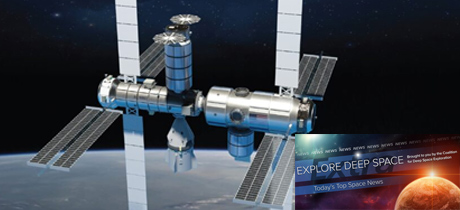Subscribe to our Daily Newsletter:
Don’t miss the latest developments in space policy, science, and exploration with Deep Space Extra, delivered directly to your inbox from Monday to Friday.
|
|
Here is a list of news that were published in our Newsletter the week of October 01, 2023:
Human Space Exploration:
- China wants a lunar satellite constellation to support deep space missions
- Musk: “Decent chance” of Starship reaching space next time
- Russia talks a big future in space while its overall budget is quietly cut
- China to send new modules and co-orbiting spacecraft to Tiangong space station
- Northrop Grumman to join Voyager Space commercial space station project
- Axiom Space partners with Prada on Artemis spacesuits
- We don’t know enough about the biomedical challenges of deep space exploration
- Artemis Accords signatories seek to boost transparency and safety in lunar exploration
- China outlines Chang’e-8 resource utilization mission to the lunar south pole
- Northrop Grumman likely to end its bid for a commercial space station
- Once seen as the future, Boeing struggles to make a case for Starliner
- Space activity on record pace during first three quarters of 2023
Space Science
- How much snow does Mars receive?
- NASA wants a ‘lunar freezer’ for its Artemis moon missions
- AI is already helping astronomers make incredible discoveries. Here’s how
- Hundreds of free-floating planets found in the Orion nebula
- Chinese astronomers say their new space telescope will outdo Hubble
- ‘Lightning’ on Venus may not be lightning at all, Parker Solar Probe finds
- Ars takes a close-up look at the first U.S. lunar lander in half a century
- U.K. startup readies new satellite that will make semiconductors in space
- Virgin Galactic, new boosters dominated suborbital launches in 2023
- Space Force goal of a multi-vendor space network called impractical
- Japan’s SLIM ‘moon sniper’ spacecraft leaves Earth orbit
- In lucky break for NASA’s Psyche asteroid probe, thruster problem discovered and quick fix found
- These are the next comets that will be visible in 2023
- The Milky Way’s mass is much lower than we thought
- NASA’s next stop: An asteroid named for the Egyptian god of chaos
- NASA to extend New Horizons mission through late 2020s
- New research provides explanation for the origin on Saturn’s rings and icy moons
Other News
- Virgin Galactic to launch Galactic 04 space tourist flight October 6. Here’s what to expect
- Weather 80-percent favorable for tomorrow’s Atlas V mission for Project Kuiper
- Japan’s SLIM moon lander makes lunar flyby
- FCC issues first space debris fine
- Starfish Space wins NASA contract to plan demonstration of orbital debris inspection
- See Jupiter meet up with a bright moon in the night sky tonight
- How Sierra Space protects America’s next space plane, Dream Chaser
Major Space Related Activities for the Week
- The U.S. Government is funded at 2023 spending levels through November 17 thanks to an agreement between the U.S. House, Senate and the White House on a continuing budget resolution as the 2024 fiscal year got underway on Saturday at midnight. Legislators this week will resume efforts to come to a formal agreement on a dozen appropriations measures that make up the 2024 budget.
- The annual session of the International Astronautical Congress (IAC) will get underway in Baku, Azerbaijan on Monday and continue through Friday with portions livestreamed.
- World Space Week begins on Wednesday, marking the 66th anniversary of the start of the Space Age with the 1957 launch of Sputnik by the former Soviet Union. World Space Week also marks the October 10, 1967 signing of the U.N. Outer Space Treaty.
- The annual meeting of the American Astronomical Society’s (AAS) Division of Planetary Sciences got underway Sunday in San Antonio and continues through Friday.
- On Friday, United Launch Alliance (ULA) is scheduled to launch a pair of prototype satellites for Amazon’s Project Kuiper, which is a broadband satellite constellation, aboard an Atlas V rocket from Cape Canaveral Space Force Station. The launch window opens at 2 p.m. EDT.

